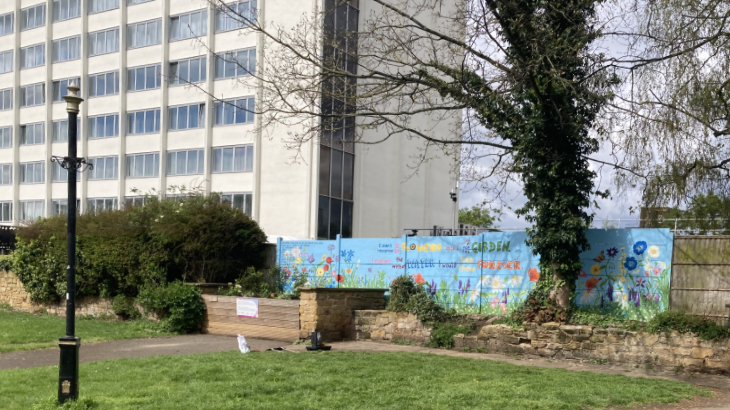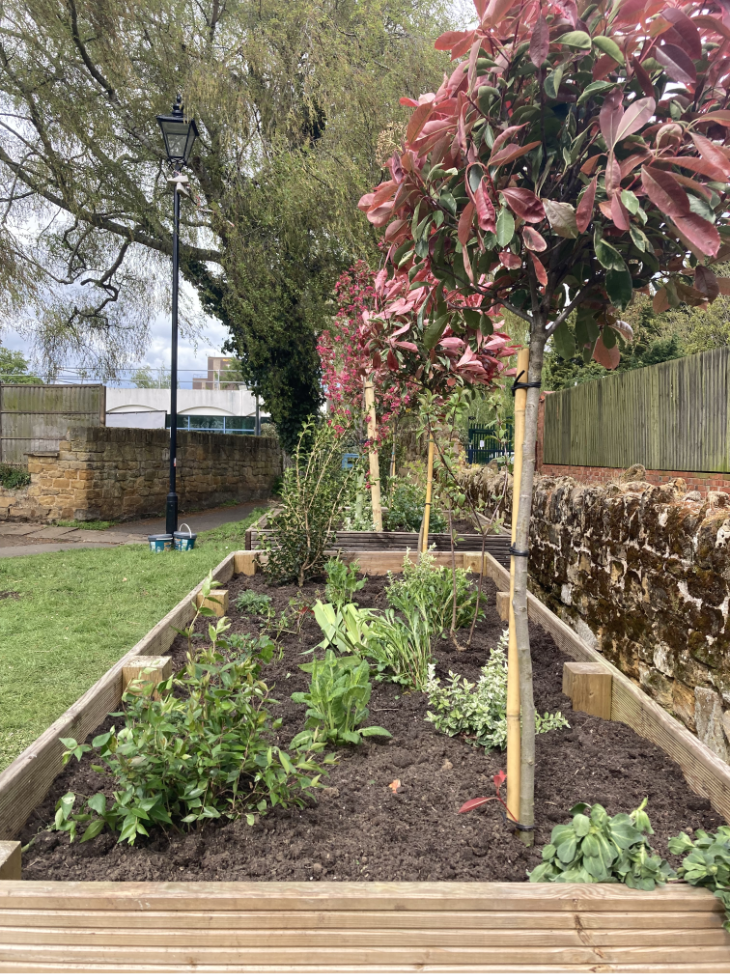St Katherine’s Garden Project

The Project - April 2024
There is a global biodiversity crisis resulting from the same human activity that is changing our climate and weather.
At the Conference of the Parties (COP) 15 for Biodiversity held in Montreal, Canada, in 2023, nations pledged to increase biodiversity by 30% by 2030 in various ways.
Northampton Town Council’s St Katherine’s Garden Project supports the COP’s target number 12: ‘Enhance Green Spaces and Urban Planning for Human Well-being and Biodiversity.’ https://www.cbd.int/gbf/targets/12
The project is also part of Northampton in Bloom, underpinned by the Royal Horticultural Society’s (RHS) guidelines to enhance perennial and sustainable planting.
There is an urgency to restore habitat loss throughout the UK with urban areas providing huge opportunities. Private gardens, community green space, river valleys, allotments, traffic islands, alleyways and verges are being restored, rewilded or re-planted across the country. Urban ecology is an increasingly important area of academic research because of the relationship between quality urban planting and well-being. Many shrubs, trees and even low growing plants also mitigate against air pollution.
Wherever there is a patch of soil there is life; soil supports plant life and animal life from soil microbes to people.
Our St Katherine’s Garden project has become an important expression of the interconnections between people and nature and the importance of restoring a neglected space equally for Northampton’s residents and for nature.
The Team
The planning, preparation and restoration has combined the efforts of different stakeholders: Northampton’s Business Improvement District who provided the funding, Northampton Town Council with councillors and volunteers from the Climate Change Forum, Northampton in Bloom, Northampton College and the Hope Centre who built the planters, St Katherine’s Church and various community groups including Immediate Justice. Praise must also be given to the dedicated Veolia employee who clears and tidies up on a daily basis.
The Planting
All plants have been selected for all-year-round structure, texture, colour and for their role in providing habitat and food for invertebrates (including insects) and birds as a minimum. There is a mixture of evergreen and deciduous shrubs and herbaceous perennials. All are hardy and long lasting if taken care of.
The three main areas of planting are the ‘mural planter’, the ‘sequence of three planters’ and the Royal British Legion memorial garden.
Fuller information about the plants selected is at the bottom of the article.
The Mural Planter
Spirea arguta produces white sprays of blossom in spring while the indigenous Viburnum opulus presents showy white pompoms.
Lime green foliage of Choisya ternate contrasts with the evergreen of the Prunus.
Colour comes from ground cover roses and herbaceous perennials such as achillea, salvias and campanulas
The Sequence of Three Planters
The planting design shows continuation, flow and connection across all three.
A statuesque crab apple tree (Malus rudolph) is given a special place in the central planter to illustrate how one tree can provide for insects, spiders and birds all year: with scented pink blossom in spring to dense foliage from spring to autumn to the small fruit which should hang as food for birds over the winter before they fall and compost to the soil. Crab apple trees need pollinating partners for the fruit to form. A second smaller crab apple has been planted to ensure pollination and therefore fertilisation to form the fruit. All fruit trees rely on one other for pollination.

The Royal British Legion Garden
Lavender has been added to the artemisia to border the design, containing salvias, poppies, cornflowers, campanulas and ox-eye daisies many of which are wild flowers.
All contribute to the red, blue and white theme. Included for structure and all year interest are Privet standards (Ligustrum jonandrum).
St. Katherine’s Garden is a hidden gem - a lovely and peaceful urban space. It is there for all to enjoy and protect.
It has been a joy to have been involved in the creation of this wonderful green space which is now remarkably improved for people and nature.
Directions to St Katherine's Garden https://www.parksandgardens.org/places/st-katherines-gardens
Plant details
Prunus lusitanica: Portuguese laurel has some benefits for wildlife, providing nesting habitats for birds, flowers for pollinators and berries for birds and small mammals.
Viburnam opulus: The Guelder Rose is indigenous to British hedgerow ecosystems in providing pollen, nectar-rich flowers, and berries. In addition, it provides great cover and protection for birds, such as thrushes, robins, and blackbirds. Other Viburnum varieties in St Katherine’s are V. bodnantense which is winter flowering providing winter and
Choisya ternate: The early spring flowers are fragrant and will attract pollinating insects seeking food in early spring. The insects will attract birds. The shrub can become dense enough to provide a nesting habit.
Euonymous fortuneii: This evergreen shrub can provide cover for small mammals as it has a spreading habit
Ground Cover Roses: These roses are great for attracting wildlife – birds feed on the autumn hips and the low branches provide shelter for many small creatures.
Malus rudolph: The Crab apple is important for local wildlife, including blackbirds, thrushes and moles who all eat the fruit.
Crab apple jelly is made from the fruit.
Abelia grandifloria is known for attracting bees. It has nectar/pollen rich and tube-like flowers.
Ligustrum jonandrum has been included to add height and structure to the RBL garden. If grown as a hedge it would provide shelter and shade for wildlife and will filter out air pollutants.
Osmanthus burkwoodii and Photinia pink marble have been chosen for scent, colour and structure. Neither are indigenous to the UK but will contribute to carbon dioxide reduction through photosynthesis as all plants will and can provide shelter and shade for wildlife. Plants like these are used in housing developments because they are often drought resistant and tolerate poorer soils. Mixed with indigenous varieties they can offer mitigation against air pollutants.
Wild Flowers: (poppies, cornflowers, feverfew): indigenous wildflowers are essential for restoring grassland habitat loss.
Herbaceous perennials such as Lavender and Achillia will attract a range of insects and birds who will feed on the seeds. These two plants have very fine, feathery leaves which can act as air filters at ground level.
The information above has been sourced from various gardening and wildlife sites including:
https://www.wildlifetrusts.org
www.rhs.org.uk
